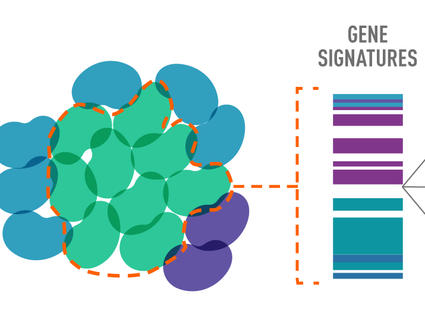Dr. Andrea Bild Enjoys the Challenging Terrain of Cancer Systems Biology
CSBC Investigator Andrea Bild, Ph.D., is a Professor in the Division of Molecular Pharmacology at City of Hope Medical Center. She is an avid hiker who has trekked up mountains in Utah and Colorado to admire the beauty of nature. Similarly, as a scientist and cancer researcher, she has set out on a journey to understand the complex landscape of cancer.
In college at the University of Florida, she volunteered in a lab that studied immune cell signaling. This experience led her to pursue a Ph.D. in Pharmacology at the University of Colorado focused on oncogenic signaling in breast cancer.
Although computational tools for sophisticated data analysis were just emerging during her time as a graduate student, Andrea recognized the potential of these informatics technologies for the exploration of tumors. Thus, as an independent investigator, she developed approaches to analyze vast amounts of data to identify coordinated patterns of oncogenic signaling.
In this interview, she shares her perspectives on cancer systems biology, tumor heterogeneity, and computational tools for cancer research.
Why did you become a cancer researcher?
Scientists get to work on challenging, complex puzzles that have the potential to help people, and we get to work with great colleagues. During my undergraduate studies, I considered other fields, such as zoology and organic chemistry; however, I landed on cancer biology due to the positive experience in my volunteer research with signal transduction and my desire to help cancer patients.
What advice do you give to your trainees in cancer systems biology?
Cross-train with other disciplines. Go to tumor board meetings with clinicians to learn their perspective on patient treatment and engage with the mathematics community to understand how they like to approach scientific problems. By working across disciplines effectively, you can accomplish broader goals.
What has been an important development in cancer systems biology?
With single cell technologies, we now can define exactly what level of heterogeneity we need to address in complex cancers, such as breast and ovarian cancer, for the development of effective treatment strategies.
Why is it important to understand tumor heterogeneity using cancer systems biology?
It’s important to understand tumor heterogeneity to effectively treat cancer cells that survive cancer therapy and continue to grow.
Currently, clinicians are not treating different subclones or the diversity of a tumor. Having a more comprehensive understanding of tumors and treating the heterogeneity could lead to better patient outcomes.
We use systems biology since it allows us to study the diverse ecosystem and complexity of a tumor. By utilizing these approaches, we can understand genomic profiles of individual tumor cells, use computational algorithms to characterize the diversity of each subclone within a tumor, and build models for predictive treatment.
How do you contribute to the development of computational tools for cancer biology research?
I always work with mathematicians and statisticians to develop computational tools for cancer biology. My role is to help identify unmet needs related to tumor heterogeneity data.
My research team is creating tools, like an integration projection model and new mathematical approaches, to understand large, single-cell genomic data sets, cell phenotypes, and subclones in tumors. With Dr. Evan Johnson, we helped to develop ASSIGN (Adaptive Signature Selection and InteGratioN) and GSOA (Gene Set Omic Analysis), which analyze complex data and make sense of signaling pathways. Also, some of our predictive models allow us to make assessments on the efficacy of clinical cancer therapies.
Based on your findings, can you describe a phenotype-targeted cancer treatment strategy?
We found that common phenotypes, such as a mesenchymal phenotype, emerge in tumors that stop responding to chemotherapy. Thus, drugs targeting pathways of cellular mesenchymal states, like AXL or cancer stem cell signaling inhibitors, may prevent or reverse this drug resistant phenotype from developing in tumor cells.
Targeting a phenotype versus a single mutation or gene target may improve our ability to match drug to tumor.
How do you translate your CSBC-supported research to clinical applications?
Once we have an actionable finding, for example a treatment regimen that our data indicates will benefit patients, we engage the medical oncologists that are a part of our scientific team. These collaborators will write up and enact a clinical trial protocol based on our collaborative research.
Our research group continues to be part of the process, and performs correlative science experiments with the clinical trial. Our team has worked together for over a decade, and we are looking forward to developing phenotype-targeting trials that help cancer patients.

